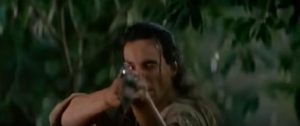THERE are few directors who can confidently say they have never made a bad film.
Michael Mann is a member of this small, elite club.
Admittedly he doesn’t have the output of others, with only a dozen features to his credit across four decades.
But hey, you’ve still got to produce the goods, right?
Mann’s filmography starts with The Jericho Mile in 1979 and includes Thief, The Keep and Manhunter in the ‘80s, The Last of the Mohicans, Heat and The Insider in the ‘90s and Ali, Miami Vice and Public Enemies from the 2000s.
Probably his weakest film was his last, Blackhat in 2015, but even that wasn’t below par, despite the unlikely casting of Chris Hemsworth as a computer hacker.
Mann is what they call a maker of ‘propulsive’ films; they have a structure and construction that seems to keep the story in a constant state of forward movement; even when characters are talking there’s a momentum on-screen that keeps holding audience interest and pushing the narrative forward.
The crime saga Heat from 1995 is definitely Mann’s crowning achievement but, for sheer entertainment, energy and excitement, his 1992 version of The Last of the Mohicans is still hard to beat.
From the opening sequence, with Daniel Day Lewis as Hawkeye leading the hunting team sprinting through the forest after their prey, to the final, hand-to-hand confrontation on a cliff face, Mann keeps his audience constantly engaged and on the edge of their seats.
It’s also a beautiful looking film with cinematography by Italian Dante Spinotti using what appears to be natural light to stunning effect in depicting the 18th Century environment that means so much to the Native American inhabitants compared to the European invaders.
Films like Mel Gibson’s Apocalypto from 2006 and 2015’s acclaimed The Revenant both owe something to the Mann aesthetic and energy.
Mann’s adaptation (he also co-wrote the script) of the classic James Fenimore Cooper novel apparently eschewed some of the more controversial socio-political aspects to portray the Native Americans as more complicated than the simple prototype of a ‘noble savage’.
The tribes have a long and complex history, led by intelligent and diverse leaders whose opinions and motivations have been forged in the ideals and actions of their forebears but changed and impacted by more recent events.
Implicit in their motivations is the anger they feel at having their lands destroyed and people decimated by the conflict between the English and French forces over country that doesn’t belong to them.
Perhaps the film paints the foreigners in a simplistically negative manner, but it’s hard to argue with history and there are glimmers of humanity and understanding from key supporting figures in the eldest daughter of a British colonel and one of his captains.
Day Lewis is, as always, effortlessly brilliant in his portrayal of Hawkeye/Nathaniel who is torn between the love of his people and a woman, but I also highly rate the performance of Wes Studi who makes the character of Magua both disturbing and charismatic in his relentless opposition to the white man’s destruction of his home and family.
Finally, the soundtrack by Randy Edelman and Trevor Jones, with central theme performed by Irish group Clannad and constantly re-arranged, also helps propel the film to its terrific, emotional climax.
Even when compared to the likes of Braveheart, Gladiator and the aforementioned Apocalypto and The Revenant, I think The Last of the Mohicans continues to be badly under-estimated.
